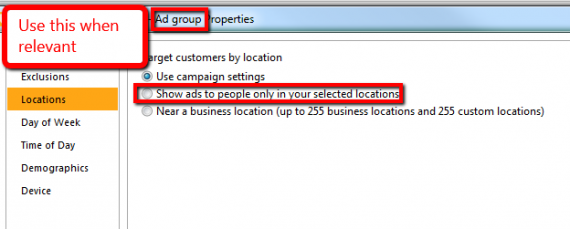There are key location targeting differences in the settings between Bing and Google, and mobile and desktop. Most advertisers run geo-reports to see where to run ads, but few measure the impact of their location targeting setting decisions. These settings will impact campaign performance for many advertisers. Let's dive into it so you can better understand how to optimize your campaign settings.
Google offers three basic options for advertisers. You can show ads to people in the targeted location, people searching for or viewing pages about my targeted location, or both. Google defaults to the combination of both in order to maximize their own revenue.
Recommendation #1 - For Google mobile search campaigns, don't use the 'people in my targeted location' option.
I make this recommendation based on how Google decides what's in targeted locations. This varies based on whether a user is on a desktop or a high end mobile device. Google starts with domain (.ca for Canada, .de for Germany, etc.) and IP addresses, but then adds a host of other variables for mobile devices, including GPS, Wi-Fi, Google Maps My Location and search history.
The fact that Google looks at mobile search history to determine my targeted location is critical. This is worth repeating. For mobile PPC, based on search history, Google may decide what people are in my targeted location.
If Google is using search terms to determine what people are in my targeted location, then there is no difference between 'people in, searching for, or viewing pages in my targeted location' and 'people in my targeted location' in mobile search campaigns. 'Viewing pages' is only a setting applicable to content. 'Searching for' is already being used to determine my targeted location for mobile. The top two settings are de facto the same thing for mobile seearch. By choosing 'people in my targeted location' you're not actually changing targeting methods. You're just cutting down on volume.
Recommendation #2 - Check the dimensions tab to see which type of targeting is performing better by campaign.
Geo-targeting options aren't a 'check off the box' variable. Plenty of people run geo-targeting reports to see if any regions are doing poorly (you should be doing this), but few people look at how the settings are performing compared to one another. Location of interest and physical location can perform very differently.
Do an analysis to check for what's working. Look at conversion rates and CPC's. If they vary drastically, you might want to split the campaign up to manage each differently, or change your targeting strategy. This can make a big difference. For one of my clients, in a state with lots of tourism (Colorado) and decent volume, the location of interest had a 29% lower CPA.
Recommendation #3 - Take advantage of Bing's ad group level geo-targeting.
On Bing, you can set geo-targeting at the ad group level. On Google, geo-targeting is done entirely at the campaign level. Take advantage of this functionality on Bing. Let's say you're an e-commerce company selling shoes and clothes. In my shoes campaign, I may not want to show the sandals ad group in the northern USA in December. I may not want to show the winter boots ad group in South Florida ever.
Remember to do the following with regard to location targeting settings
1. Don't use 'people in my targeted location' for Google mobile search campaigns
2. Optimize Google campaigns by targeting settings
3. Take advantage of Bing's ad group level geo-targeting.
These are ways to stand out relative to other advertisers, most of whom are just running geographic reports to get information on performance by location. For superior performance, run geographic reports on performance by location AND analyze how the settings you chose are impacting performance.
What other ways have you optimized location targeting settings?




